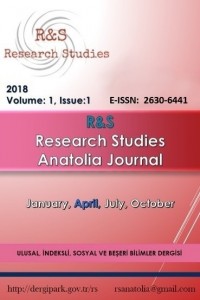Abstract
Bu
araştırmanın amacı; ilköğretim okulları 8. sınıf Teknoloji ve Tasarım dersi
kurgu kuşağında yer alan “ Çözüm önerilerinin yasal koruma altına alınma
yollarını ve sürecini ifade eder ” kazanımının kendiliğinden örgütlü ortamlarda
kendi kendine öğrenilmesinin etkililiğini belirlemektir. Araştırma için gerekli
olan veriler kontrol gruplu deneysel model kullanılarak ön test ve son test
uygulanarak elde edilmiştir. Araştırma 2011-2012 eğitim-öğretim yılında Ankara
ilinde MEB’ e bağlı bir ilköğretim okulunun 8.sınıfında 32 öğrenciyle
gerçekleştirilmiştir. Araştırmada öğretim kontrol grubunda (n= 15) öğretmen
merkezli yöntemle (geleneksel yöntem), deney grubunda (n= 17) kendi kendine
öğrenme yöntemi ile kendiliğinden örgütlü ortam kullanılarak bilgisayar destekli
olarak gerçekleştirilmiştir. Araştırmada kullanılan testler, konunun
işlenmesine başlamadan önce ön test, konu işlendikten sonra ise son test
uygulanmıştır. Araştırmada kontrol ve deney grupları arasındaki farklılıkları
belirlemek üzere veri analizinde ilişkisiz örneklemler t-testi, grupların kendi
içindeki farkı belirlemek için t-testi kullanılmıştır. Denencelerin test
edilmesinde anlamlılık düzeyi 0,5 olarak alınmıştır. Aynı zamanda öğrenci
kişisel bilgilerin analizinde yüzdelik ve frekanstan yararlanılmıştır.
Araştırma elde edilen bulgular sonucunda “kendiliğinden örgütlü ortamlarda
kendi kendine öğrenme süreci” uygulandığı deney grubunun, geleneksel öğretim
yönteminin uygulandığı kontrol grubundan daha etkili olduğu görülmüştür.
References
- Alkan C. (1998). Eğitim Teknolojisi. Anı Yayıncılık, Ankara.
- Chakravarthi S.(2010). Analysis of the psychological impact of problem based learning (PBL) towards self directed learning among students in undergraduate medical education. International Journal of Psychological Studies. Kuala Lumpur, 2(1): 38-41.Kuala Lumpur.
- Demirci S.F.(2011). ”Eğitim ve Verimlilik ”, Bilim ve Aklın Aydınlığında Eğitim Dergisi,15-16.
- Gül İ.(2007).Eğitimin Toplumsal Temelleri. Cafoğlu Z. Eğitim Bilimine Giriş (ss.162)Grafiker Yayıncılık. Ankara.
- Kocaman, G. (2004). Dokuz Eylül Üniversitesi 1.Eğitim Kurultayı, DEÜ Hemşirelik Yüksekokulu, [http://web.deu.edu.tr/aek2004/12/Kocaman.pdf ].Erişim tarihi:09.02.2012
- Malik S. & Shabbir M.S.(2008). “Perception of University Students on Self-Directed Learning through Learning Technology”. European Journal of Scientific Research.24(4): 567-573. Islamabad
- Mitra S. Dangwal R.(2010).”Limits to self-organising systems of learning—the Kalikuppam experiment”. British Journal of Educational Technology. 41(5).681-686. Newcastle.
- Mok M.M.C. Lung C.L.(2005). “Developıng self-dırected learnıng ın student teachers”. International Journal of Self-Directed Learning. 2(1), 18-28. Florida
- Polat C. Odabaş H.(2008).Bilgi Toplumunda Yaşam Boyu Öğrenmenin Anahtarı: Bilgi Okuryazarlığı. Küreselleşme, Demokratikleşme ve Türkiye Uluslararası Sempozyumu Bildiri Kitabı. Antalya
- Şimşek A.(2009).Öğretim Tasarımı. Nobel Yayın Dağıtım. Ankara
- Toru, F.(2010).”Story-based pedagogical agents: a scaffolding design approach for the process of historical ınquiry in a web-based self-learning environment”. Unpublished Doctoral Thesis,Pennsylvania State University 60.
Abstract
The Fiction Section of the 8th Grade technology and design course has a well-known learning output that students should learn the legal protection methods and process. This study aims to determine the effectiveness of the self-directed learning process in achieving this result in self-organized environments. Toward acquiring the date necessary for the study, was made use of the control-group were applied model and pre and end-tests. The research has been conducted in the city of Ankara with 32 8th graders of a primary public school directed by the Turkish Ministry of National Education (MoNE) in 2011-2012 academic year. This computer-supported research had 15 students in the control group where the method of teaching was teacher-centered (that is the traditional) method, whereas 17 students in the test group where the method of teaching was self-directed learning that created a self-organized learning environment were applied the tests twice in both groups; before starting to teach the course unit as a preliminary test and after having taught the course unit as a end test. In the process of data analysis, to determine the differences between the control group and test group the research employed the independent samples t-test, and the differences within each group the paired samples t-test. In testing the hypotheses, the level of significance has been accepted as 0,5. In addition, in the analysis of students’ personal information were employed the percentile and frequency methods. Based on the results of these tests, the study concludes that the test group where the self-directed learning method in a self-organized environment has been applied is more effective than the control group where the method of teaching is traditional.
Keywords
Learning Self-Directed Learning Self-Organized Environment Traditional Method Applied Method
References
- Alkan C. (1998). Eğitim Teknolojisi. Anı Yayıncılık, Ankara.
- Chakravarthi S.(2010). Analysis of the psychological impact of problem based learning (PBL) towards self directed learning among students in undergraduate medical education. International Journal of Psychological Studies. Kuala Lumpur, 2(1): 38-41.Kuala Lumpur.
- Demirci S.F.(2011). ”Eğitim ve Verimlilik ”, Bilim ve Aklın Aydınlığında Eğitim Dergisi,15-16.
- Gül İ.(2007).Eğitimin Toplumsal Temelleri. Cafoğlu Z. Eğitim Bilimine Giriş (ss.162)Grafiker Yayıncılık. Ankara.
- Kocaman, G. (2004). Dokuz Eylül Üniversitesi 1.Eğitim Kurultayı, DEÜ Hemşirelik Yüksekokulu, [http://web.deu.edu.tr/aek2004/12/Kocaman.pdf ].Erişim tarihi:09.02.2012
- Malik S. & Shabbir M.S.(2008). “Perception of University Students on Self-Directed Learning through Learning Technology”. European Journal of Scientific Research.24(4): 567-573. Islamabad
- Mitra S. Dangwal R.(2010).”Limits to self-organising systems of learning—the Kalikuppam experiment”. British Journal of Educational Technology. 41(5).681-686. Newcastle.
- Mok M.M.C. Lung C.L.(2005). “Developıng self-dırected learnıng ın student teachers”. International Journal of Self-Directed Learning. 2(1), 18-28. Florida
- Polat C. Odabaş H.(2008).Bilgi Toplumunda Yaşam Boyu Öğrenmenin Anahtarı: Bilgi Okuryazarlığı. Küreselleşme, Demokratikleşme ve Türkiye Uluslararası Sempozyumu Bildiri Kitabı. Antalya
- Şimşek A.(2009).Öğretim Tasarımı. Nobel Yayın Dağıtım. Ankara
- Toru, F.(2010).”Story-based pedagogical agents: a scaffolding design approach for the process of historical ınquiry in a web-based self-learning environment”. Unpublished Doctoral Thesis,Pennsylvania State University 60.
Details
| Primary Language | Turkish |
|---|---|
| Journal Section | Articles |
| Authors | |
| Publication Date | April 25, 2018 |
| Submission Date | April 8, 2018 |
| Acceptance Date | April 17, 2018 |
| Published in Issue | Year 2018 Volume: 1 Issue: 1 |

